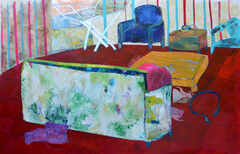Vera Tamari is a famous Palestinian artist. She is also my dearest friend and neighbor. One day before Ramallah’s fourth invasion on June 24th, she inaugurated an art installation entitled ‘Going for a ride’. The unique exhibit consisted of crushed and twisted cars from the first invasion to Ramallah on March 29th.
The art installation was located in a playground connected to the Friend’s Boys school, the oldest Quakers school in the Ramallah area. The location of the exhibit was chosen strategically, in order to set as background a panoramic view of the illegal Israeli settlement of Pessagot, which completely dominated the space around the exhibit.
Many curious people from all around the Ramallah area—young and old, men and women—all came to see how some smashed-up cars could be transformed into ‘ojects d’art’. The artist placed five cars, ranging from totally to half-demolished, on a well paved, open-ended road parallel to the direction of the settlement.
In the crushed cars, lively music was playing, and colorful folkloric items were suspended over the rear-view mirror, such as blue eye, kaff [Hand of Fatima], massbaha [worry beads], etc., all symbols meant to safeguard the driver from the “evil eye” and others’ envy.
Among the spectators were a group of 5 young boys, ranging from 10 to 14 years of age. The many scars on their faces evidenced their disadvantaged social background. Their presence at an abstract art exhibition intrigued me, so I decided to keep an eye on them. I saw they tended to touch the cars, open their doors, play with the cassette players inside the cars and they even start ‘taking’ some parts of the smashed cars. Seeing this, I decided to intervene. I approached them and asked if they liked the exhibition and if they understood the meanings of the symbols, the tank’s traces behind the smashed cars, the music, the good luck charms hanging from the rear-view mirror, the view of the settlement and the road with the open end.
The music, I explained, is a sign of the continuation of our lives; it shows that in spite of all this destruction, we are not broken and we still feel life and enjoy it by listening to the music. It shows you that when you face a destructive power you should go on and not be broken, that is why the name of the exhibit is ‘Going for a Ride’. Then I added, “You are still young and you might face a situation in which you have to pay a price for enjoying your lives as free citizens and you still have long way to go.”
When I was talking to them, I don’t know why, but I could not stop looking at one of the young boys. He had very wide, very beautiful black eyes. His friend, who was putting his hand on his shoulder, said in a perfectly normal, cool voice: “His brother is a shaheed (martyr). My house was demolished.”
His words shut me up immediately. I did not know what to say, it was as if he was answering me by saying that, “Even at our young age, we have already paid our price.”
The only spectators now, one day after the inauguration of the exhibit, are the army tanks. I saw them from my balcony. They stopped and directed their lights at the art installment, perhaps considering whether or not to crush the cars again.
“It’s as if they want to tell us, ‘When you are under our control, there is no art that can ever come out of here,’ said Vera sadly.


